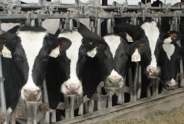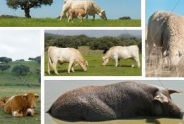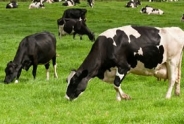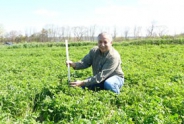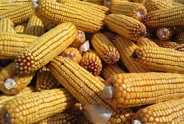Beef x Dairy Workshop - Postponed to Winter time!
Event Details
Date
April 27, 2022
November 23, 2022
Host
Southwest New York Dairy, Livestock and Field Crops ProgramCamila Lage
607-422-6788
email Camila Lage
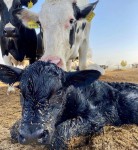
Given the challenging conditions within the dairy industry today, dairy farmers are seeking solutions to enhance their bottom lines. Replacement animals typically account for 15 to 20 percent of milk production costs, but advancements in reproductive management on many farms resulted on an oversupply of dairy replacement heifers relative to anticipated herd needs, which has contributed to economic strain for many dairies. Male dairy calves, and about one third of dairy heifers, are sold as calves at a steep discount compared to traditional beef calves because of lower efficiency and yield. In today's market, dairy calves may sell for $0-$80 while crossbred calves can sell for $100-$330. For dairies of all sizes, selectively breeding some dairy cattle to beef bulls via artificial insemination represents a potential increase in gross profits. Small, relatively inexpensive changes in management can have the potential to make large impacts for the dairy farmer, the beef market, and for local communities.
An increase of quality crossbred calves in the marketplace can benefit beef farmers because they grow more similarly to pure beef animals, and more efficiently than pure dairy calves. Making sure crossbred calves are treated optimally from birth provides higher quality young stock for farms that raise and finish beef. Crossbred cattle tend to grade better than pure dairy animals, resulting in high quality cuts for the consumer market while requiring less feed to get to marketable size than pure dairy animals. This reduces input costs as well as the environmental impact per pound of beef produced. Through the use of this technology, profits for both dairy and beef producers can increase, and more beef can be made available to communities in our region.
Our objective is to enhance the knowledge of beef and dairy producers to help 1) Dairy farmers proactively manage their cow and heifer inventories to increase the genetic potential of replacement heifers and the income from calves not used for herd replacement, 2) Beef farmers learn what makes a good crossbred calf and that there is potential for crossbred animals in the beef herd, and 3) Connect dairy and beef farmers so they can work together to produce a healthy and efficient calf that will create value for the whole beef supply chain.
Program Topics
- Economics of Adopting Beef x Dairy on your Herd
- Make the Most out of Beef x Dairy in your Herd
- Setting up your Calves for Success
- Assuring the Market Value of Crossbred Calves
- Marketing your Finished Beef x Dairy Animals
- Roundtable Discussion
When: Postponed until winter time!
Upcoming Events
Cornell Seed Growers Field Day
July 2, 2024 : Cornell Seed Growers Field Day
Ithaca, NY
Save the Date!
North American Manure Expo
July 17 - July 18, 2024 : North American Manure Expo
Auburn, NY
Save the Date for the North American Manure Expo
Professionalism in Nutrient Management - www.manureexpo.com
Sundaes on the Farm
July 21, 2024
Spencer, NY
Learn about Tioga County Agriculture! IFree Admission! Enjoy Ice Cream, Animals and Farm Tours, Kid's Activities, Food, Live Music, and Farm Vendors.
Announcements
Farm Participants Needed for Bale Grazing Grant!
Information on the Project:- Approximately 10 acres total needed to bale graze two different bale densities
- "Core" farms will graze two winters, "Demo" farms will graze one winter.
- Payments for both "Core" farms and "Demo" farms
- Baseline soil sampling by bale grazing team
- Forage measurements in early season by bale grazing team
- Late season clipping if residual not trampled down by farm
Cornell Cow Convos - New Podcast
On-going podcast, New episodes released on the last Thursday of the month.Guest speakers, CCE Dairy Specialists.
Housed on Soundcloud Channel is CCE Dairy Educators
- Preventative healthcare for cows
- The trend of beef on dairy
- What to look forward to in the new year for dairy
- Socially grouping or pair-housing calves
Dairy Acceleration Program Funds Available
- organization of financial records/benchmarking up to $1,000
- continued business planning (for farms awarded in a previous year) up to $2,500
- business planning up to $5,000
2018 Drug Residue Prevention Manual
For more than 30 years, the U.S. dairy industry has focused educational efforts on the judicious use of antibiotics through the annual publication of a Best Practices Manual. The 2018 edition of the National Dairy FARM Program: Farmers Assuring Responsible Management? Milk and Dairy Beef Drug Residue Prevention Manual is the primary educational tool for dairy farm managers throughout the country on the judicious and responsible use of antibiotics, including avoidance of drug residues in milk and meat.The manual is a quick resource to review those antibiotics approved for dairy animals and can also be used as an educational tool and resource for farm managers as they develop on-farm best management practices necessary to avoid milk and meat residues. Visit the Manual and Form Library to download copies of this important tool!
Follow us on Facebook
The team updates our facebook page frequently - follow us to be updated on our events, see some fun videos and get local area updates!facebook.com/SCNYDairyandFieldCropsTeam
ProDairy Forage Management
Are you prepared to change your routine this spring?While spring tasks vary by farm, there are many "rites of spring," and they are often completed in a fairly rigid sequence. Depending on the farm, these often include fixing fence, spreading manure, planting new seedings, planting corn and harvesting first cutting, and are often performed in this order.
We are optimistic that the upcoming turn in weather will allow these task to be accomplished in a timely manner, but at this point it is time to ask yourself: Are you willing to change your spring routine?
In addition to adverse weather it is no secret that everyone is facing extremely tight economic times, and dealing with forage inventories of poor digestibility forages from 2017. This combination of factors makes it more critical than ever to be ready to tackle the task that will have the most impact on your business at the proper time.
Recent reference articles on dealing with tough times:
• Key Opportunities to Optimize 2018 Crop Production Efficiency
• Resources for Dealing with Spring Weather Delays
First Cutting
The number one focus should be on timely harvest of first cutting.
• Park the corn planter when a field of first cutting is ready for harvest.
o Monitoring 1st cut harvest timing
• Approach harvest by the acre, not by the field. Be ready to skip over a field that has passed its optimum harvest stage.
o Dynamic Harvest Schedules
• Strategically plan feed storage to best utilize forage inventories for the right group of animals.
o Strategic Forage Storage Planning
o When More is Better
Corn Planting
The window for planting for silage is generally wider than for grain, which is why first cutting can and should take priority over corn planting. However, in the event of extreme delays in planting corn, performance will diminish with late plantings. If corn planting progresses into late May or early June, begin to consider alternative options for those acres. Previous research from Cornell and Penn State suggest a 0.5 to 1 ton/acre per week decline in silage yield for planting after mid to late May.
Multi-Tasking
First and foremost during a time of year that can be very busy and stressful, taking every precaution to keep your team safe is critical.
The idea of fitting all of this work into a condensed time period, and still getting key tasks completed before critical deadlines can seem impossible, but year after year many find unique ways to get it all done. Consider working with neighbors, custom operators or renting equipment to accomplish these key tasks on time.
If you currently utilize custom operators, now is a good time to set up a time to meet with them and make sure you are on the same page to get tasks accomplished in the time-frame needed. Make sure that your expectations and goals are clearly defined. They will also be under stress to fit their work into a condensed period and meet their customers' expectations, so defining expectations and pre-planning how to most efficiently get the work accomplished when the custom operator arrives can go a long way to increase the chances for success.
NYSERDA Agriculture Energy Audit Program
NYSERDA offers energy audits to help eligible farms and on-farm producers identify ways to save energy and money on utility bills. Reports include recommendations for energy efficiency measures.For more information and the NYSERDA Agriculture Energy Audit Program Application click here

